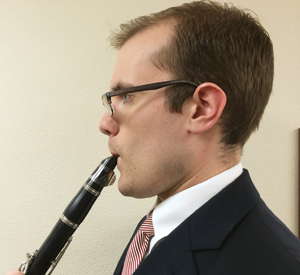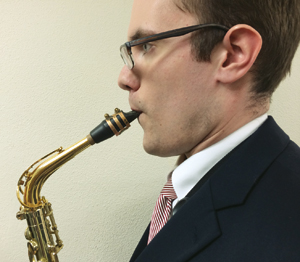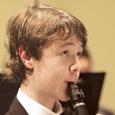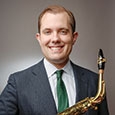In the lazy days of summer, band directors across the country will enjoy a well-deserved, albeit brief, respite from their incredibly busy school-year schedules. All too soon, however, the work of educating young musicians will be back under way. At this time, it is perhaps profitable to reflect upon new ways to think about things for the new year. This article offers some new ways to think about clarinet and saxophone pedagogy. The goal here is to identify some of the finer differences between basic clarinet and saxophone pedagogy so that beginning students (and older students, for that matter) can get off to the best start possible when the new school year begins. Some of these key differences are sometimes overlooked and can lead to unfortunate results.
The Clarinet vs. the Saxophone
Many years ago, the clarinet and saxophone were often seen as very closely related instruments. The saxophone was commonly viewed as an instrument that could easily be picked up once the clarinet was mastered. Fortunately, this erroneous belief, with its terrible ramifications for the saxophone, has largely gone the way of the dodo. Unfortunately, however, some of the pedagogy that originated in this time period has remained, and as a result, many people still equate some of the performance basics of the two single-reeds.
The tendency to treat clarinet and saxophone pedagogy as the same was common in the 1920s and 30s, but if you look back further, there was not a unified approach to the instruments. Although Adolphe Sax was trained as a clarinetist, he did not advocate a clarinet-like embouchure for the saxophone. When you look at early method books, the recommended approach was still a more cushioned embouchure for the saxophone than for the clarinet. Then, after a long time had passed, especially after the Sousa band players faded away, much of the original saxophone pedagogy went out the window, except in places like Detroit and Chicago, where there were plenty of great players who knew the differences between the two instruments. Unfortunately, some of the resultant misconceptions have carried over into the modern day.
The problems that result when clarinet and saxophone are taught in the same way are numerous. The biggest of these problems are poor intonation, thin sound, strident tone, and difficulty playing in low and high ranges. Mostly these problems arise because the pedagogy does not properly transfer between the two instruments. Embouchure is a critical difference. Many problems occur when a student tries to play saxophone with a clarinet-like embouchure. If students are taught a correct saxophone embouchure, many of the problems that students often have with low range playing are not nearly as pronounced.
When teaching students, the clarinet and saxophone should be treated as distant cousins, at most. Acoustically, the instruments are quite foreign to each other, and the proper sound concept, instrument response, and even reed construction are radically different from one another. Although both instruments share a single reed and some similar fingerings, and while a skilled doubler could become extremely proficient at both, the two instruments should be approached pedagogically as different animals.
Instrument Carriage
The differences begin with something as basic as the position of each instrument in relation to the player. As simple as it may sound, even just the angle at which the clarinet or saxophone mouthpiece enters the mouth can make all the difference in the world, timbrally. For the clarinet, the instrument should be held at approximately a 35- to 40-degree angle from the body. This can be easily visualized with the student clarinetist sitting down, bringing the clarinet to the embouchure (while sitting up straight with the head facing forward), and centering the bell of the instrument between the knees. For most people, this approach will yield the appropriate angle, and it can also be used to generate proper position while the player is sitting or standing.
For the saxophone, the angle at which the mouthpiece enters the mouth should be quite different, at about 70 to 75 degrees in relation to the player. Have students think of a straight saxophone. The bell would not be pointed straight out or at a 45-degree angle, but rather, somewhere in between. Any students who struggle to visualize this should try it with just the mouthpiece and the neck.

The clarinet should be at a 35- to 40-degree angle to the body, while the saxophone mouthpiece should enter the mouth at about 70-75 degrees.

This can also be easily achieved through a few physical steps. First, have the alto saxophone player stand up and adjust the neckstrap so that the saxophone will be at embouchure-level without having to hold the bottom half of the saxophone out away from the body. The Eb keyguard on the back of the alto should be in contact with the front of the player’s body at all times when standing (except for during marching band playing, for obvious reasons). With the neckstrap supporting all of the weight of the instrument, bring the mouthpiece directly into the embouchure (while the player holds his head naturally, with no bending down or craning up). Then, if the Eb keyguard on the alto remains in contact with the player’s body, the proper angle should be achieved.
As insignificant as this first step may seem, it holds the key for much of the embouchure advice to follow. Indeed, finding the proper mouthpiece angle is a critical first step toward achieving a characteristic sound on both instruments. This subject also leads to the topic of the proper hand position.
Holding the Instrument
The proper technique for holding the instrument is an important subject that deserves attention. The key difference in holding the clarinet and the saxophone properly is that the clarinet should be held away from the body, whereas the saxophones, with the exception of the soprano, should always make contact in some way with the body when the player is standing. Just as the Eb keyguard should touch the right hip or leg of the student playing the alto saxophone, for tenor or baritone, the instrument should contact the student’s right side. It is important to remember that under no circumstances should the saxophone ever be held out from the body (except when marching). Holding the saxophone away from the body can cause fatigue and tension in the right hand, which causes problems with technique and possibly physical problems as well.
For sitting while playing the saxophone, when it feels comfortable to do so, the alto sax should be moved from off to the side to straight in front of the player. This is a change that is usually made when the student is about 5 feet, 4 inches tall.
The soprano saxophone, because of its construction, must be held away from the body, but the saxophonist should pay careful attention to the angle at which the mouthpiece enters the mouth. The soprano should always be at the proper angle for saxophone, rather than at the angle for clarinet. In addition, the soprano’s weight should always be supported by a neckstrap. (On the clarinet also, a neckstrap is advisable in order to help avoid fatigue and tension.)
With regard to hand position, there are slight differences between saxophone and clarinet. For both instruments, the hands should be naturally relaxed, with no excess tension. To visualize this, students should drop their hands at their sides and relax. Then they should raise their arms, with the hands still in a relaxed state. If this is done correctly, the fingers should form a shape like the letter C.
The difference between clarinet and saxophone hand positions arises in where the fingers make contact with the tone holes or keys of the instruments. On the clarinet, the fleshy part of the last joint of the finger should be used to seal the tone-holes. On the saxophone, the slightly harder skin closer to the tip should be used. On neither instrument should the absolute fingertips be used, and the fingers should never be straight. Rather, something close to the initial C-shape should always be used, with all finger motion originating at the knuckle.
Embouchure
The embouchure is the area where there should be the greatest difference between the clarinet and the saxophone, but unfortunately, on this subject, the instruments are still too often equated with each other. For the clarinet, the mouthpiece should be pushing up very slightly into the teeth (as a result of the right hand pushing up slightly into the thumb rest), and this anchors the mouthpiece. The lower lip then should be brought over the lower teeth as a cushion. None of the wet area of the lip is to be exposed, but the reed should make contact with the red, fleshy part of the lip. The clarinetist then should firm the corners of the mouth outward, as if drawn by a string, sealing in the air. The chin points downward, yielding a firm, but certainly not tight, embouchure.
The saxophone embouchure, by contrast, should be a bit more cushioned. The top teeth should rest on the top of the mouthpiece, with the weight of the head anchoring the embouchure in place. The lower lip will be used as a cushion over the teeth, in a manner similar to the position used on the clarinet. However, before sealing the embouchure, the corners of the mouth should be brought in, creating a more pillowy lower lip. Finally, the chin should be drawn downward, although not to the degree of pointing it, as is done with the clarinet.
Both of these embouchures can be checked to ensure appropriate tension through a fairly easy process. On clarinet, the mouthpiece and barrel should be removed and played alone. The resultant pitch should be a concert F#5. Similarly, the mouthpiece of the saxophone can be removed. A soprano saxophone should produce a concert D#6, an alto a B5, a tenor a G#5, and a baritone a D#5 (this will be much more difficult to do than on clarinet).
Tonal Models
Some of the confusion surrounding differences in clarinet and saxophone performance stems from the fact that many of the pedagogical materials and recordings floating around band rooms are from a different generation. In the 1950s and before, the saxophone and clarinet were often viewed as being analogous. However, since that time, the pedagogy of both instruments has diverged significantly, and the result has been better sounds and tonal concepts for both instruments. Despite this progress, many of the models that young people now listen to still can be outdated, which can lead to sounds that are anachronistic and not consistent with top performance standards today.
To avoid this problem, students should be introduced to some of today’s finest players on both instruments. On the clarinet side, recordings by Richard Stoltzman, David Schifrin, Jon Manasse, and Robert Spring will offer students a great idea of what a clarinet sound should be. Similarly, saxophone recordings by Timothy McAllister, Clifford Leaman, Kenneth Tse, and Taimur Sullivan (just to name a few) will provide a fantastic representation of great modern saxophone sounds.
Vibrato
There is a basic point about vibrato that should be common knowledge today, but it is still worth mentioning: the clarinet, generally, should be performed without vibrato (Stoltzman recordings noted), whereas the saxophone usually should use vibrato. There are exceptions to these general rules, but those are for a teacher to address in specific instances. It is also universally agreed now that saxophonists should perform with a jaw vibrato. (On this subject, please see “Teaching Saxophone Vibrato” in the September 2013 issue of The Instrumentalist.)
Articulation
A problem that has affected generations of players (to the detriment of saxophonists especially) is the tendency to teach clarinet and saxophone articulations in the same manner. Although the difference in proper articulations for the two instruments may seem slight, there is a rather large, practical difference. On the clarinet, the articulation that should be taught is a tip-to-tip technique; that is, the tip of the tongue should come into contact with the tip of the reed. Because of the difference in mouthpiece angle, this technique would cause problems (such as pop, slap, and thud tongues) if used on saxophone. To avoid this, the saxophonist should instead use an area just behind the tip of the tongue to contact the tip of the reed.
Conclusion
If the right instruction is given to clarinet and saxophone students from the beginning, without introducing the wrong pedagogy from the other instrument, it may help to head off many of the common problems noted above. With the right instruction on each instrument from the start, my hope is that beautiful and characteristic saxophone and clarinet sounds will develop and be heard in band rooms all over the country in the coming year.






